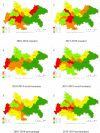Assessing the sustainability and competitiveness of tourism economies in China's Chengdu-Chongqing metropolitan area
- PMID: 35513619
- PMCID: PMC9070974
- DOI: 10.1007/s11356-022-20436-2
Assessing the sustainability and competitiveness of tourism economies in China's Chengdu-Chongqing metropolitan area
Abstract
As the competition of tourism industry becomes increasingly white-hot, the sustainability and competitiveness of tourism economies inside a zone gradually gets people's attentions. Based on data of 16 cities from 2010 to 2019, this paper aims to investigate the sustainability and competitiveness of tourism economies in the Chengdu-Chongqing metropolitan area, by constructing a niche evaluation index and four niche models (niche ecostate-ecorole model, niche expansion model, niche breadth model, and niche overlap degree model). The results show that (1) during the sample period, the niche values of tourism competitiveness in most cities of the Chengdu-Chongqing metropolitan area have shown a sustained increasing trend, indicating that the status of these cities in resources, market, environment, social economy, and other dimensions is rising steadily, and their competitive advantages are gradually increasing; (2) the niche values of tourism competitiveness in the core cities of Chengdu-Chongqing metropolitan area (Chengdu and Chongqing) remain stable, while the niche values of tourism competitiveness in the remaining cities vary greatly; the comprehensive niche values of tourism industry competitiveness of the cities in the central area are significantly lower than those of the cities in the peripheral area; (3) the niche overlap of tourism competitiveness in the Chengdu-Chongqing metropolitan area is relatedly high, indicating that the homogenization of tourism in these cities is more serious.
Keywords: Chengdu-Chongqing metropolitan area; Competitiveness evaluation; Niche theory; Tourism industry.
© 2022. The Author(s), under exclusive licence to Springer-Verlag GmbH Germany, part of Springer Nature.
Conflict of interest statement
The authors declare no competing interests.
Figures




References
-
- Algieri B, Aquino A, Succurro M. International competitive advantages in tourism: an eclectic view. Tour Manag Perspect. 2018;25:41–52. doi: 10.1016/j.tmp.2017.11.003. - DOI
-
- Almeida-Santana A, Moreno-Gil S. Perceived sustainable destination image: implications for marketing strategies in Europe. Sustainability. 2019;11(22):6466. doi: 10.3390/su11226466. - DOI
-
- Altinay L, Kozak M. Revisiting destination competitiveness through chaos theory: the butterfly competitiveness model. J Hosp Tour Manag. 2021;49:331–340. doi: 10.1016/j.jhtm.2021.10.004. - DOI
-
- Andrades L, Dimanche F (2019) Destination competitiveness in Russia: tourism professionals’ skills and competences. Int J Contemp Hosp Manag 31(2):910–930
-
- Barros CP, Botti L, Peypoch N, Robinot E, Solonandrasana B. Performance of French destinations: tourism attraction perspectives. Tour Manage. 2011;32(1):141–146. doi: 10.1016/j.tourman.2010.01.015. - DOI
MeSH terms
Grants and funding
LinkOut - more resources
Full Text Sources
Research Materials

